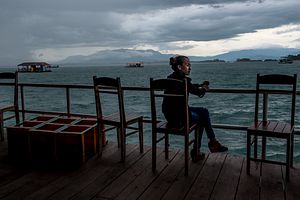Luc Forsyth and Gareth Bright have set out on a journey to follow the Mekong river from sea to source, The Diplomat will be sharing some of the stories they’ve found along the way. For more about the project, check out the whole series here.
After the quiet of Pakse and southern Laos, the sheer scale of the Nam Ngum’s reservoir took us off guard. Over the course of several days we look at how the reservoir has changed life in the area for both good and bad.
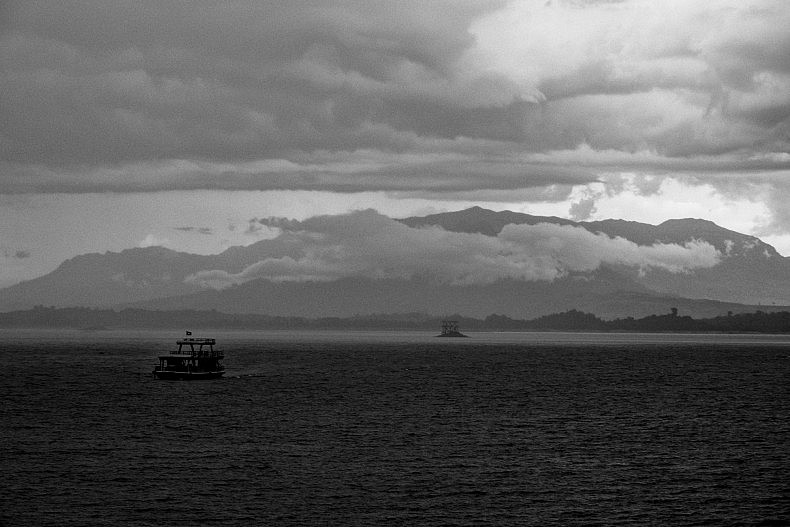
The vast reservoir created by the Nam Ngum dam has been dubbed “The Laos Sea” by many locals. Photo by Gareth Bright.
The first time we laid eyes on the Laos Sea, it was hard to process that the vast expanse of turquoise water we were looking at was man-made. As the only landlocked country in southeast Asia, Laos was not supposed to have a sea.
We’d come to the town of Thalat via Vientiane by way of a torturous overnight sleeper bus. For budgetary reasons, Gareth and I had shared a bed that might have been reasonably comfortable for an average sized Laotian, but with both of us standing over 6 feet tall and being fairly broad in the shoulder we battled constantly for space. And each time the bus broke down – which it did five times during the night – the air-conditioning system would shut off, making that battle an especially sweaty one. By the time we pulled into the station, 18 hours later, we were both furious with each other in that strange way that happens when neither person has actually done anything wrong and both parties know they have no valid reason to be angry.
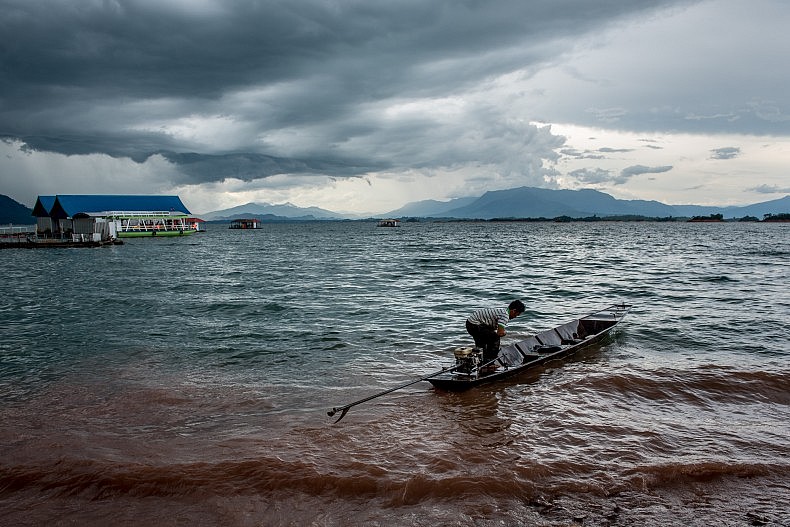
A man sets off into the Lao Sea in a boat. Photo by Luc Forsyth.
All was forgotten after a shower and a coffee, however, and an hour later we were already laughing at the ridiculousness of the journey. We had endured such a long drive in order to skip over roughly 700 km of southern Laos that was, while certainly beautiful, not what we had come to Laos to investigate.
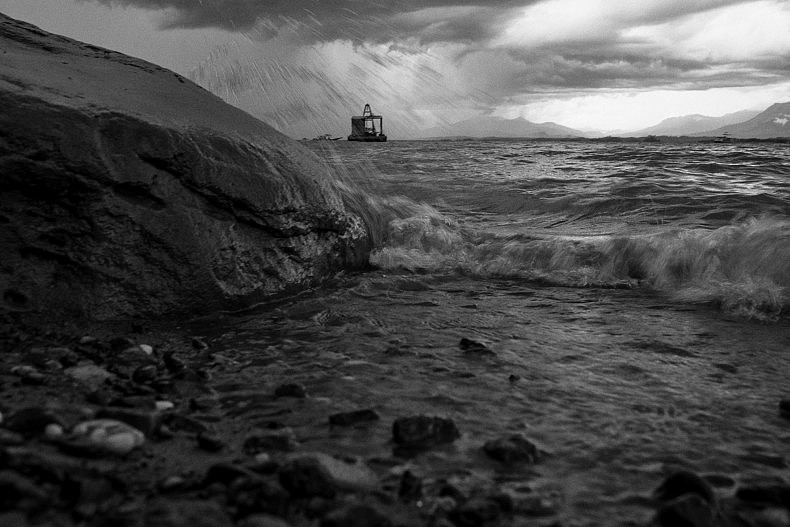
In Laos, a landlocked country, the reservoir is the largest body of water. Photo by Gareth Bright.
Building a Sea
In the late 1950’s, Laos was in the midst of an energy crisis; the country simply did not have enough electricity to meet its national needs. Less than a decade after achieving independence, and poverty stricken as it was with an unproductive economy the nation had few options at its disposal. In the words of a RAND Corporation report from the period, Laos was “hardly a nation except in the legal sense.” The answer, it seemed, was hydropower.
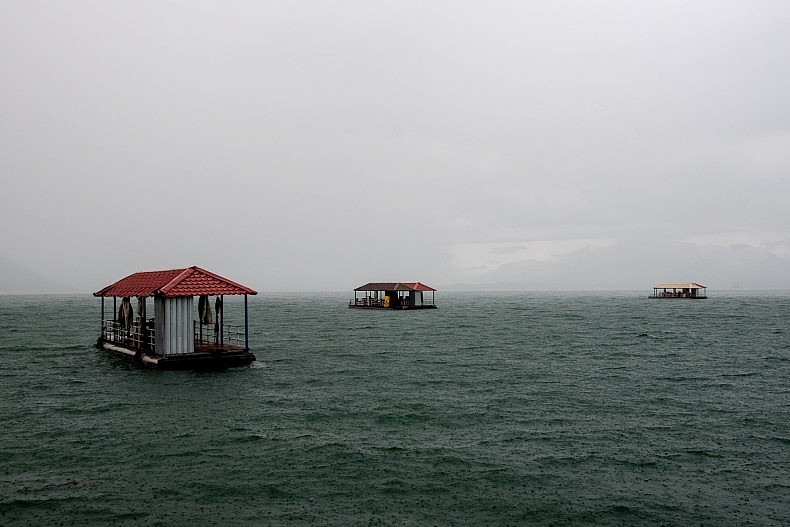
Floating party barges dot the resevoir of the Nam Ngum dam’s resevoir. Photo by Luc Forsyth.
Seeking to turn Laos into a stopgap between the rising communist states of North Vietnam and China, a group of 10 nations, with the U.S. at the forefront, donated the nearly $100 million necessary to build the country’s first hydroelectric dam. Situated on the Nam Ngum river, one of the Mekong’s major tributaries and along which nearly 1 million people live today, the reservoir created by the dam when it was completed in 1984 became the largest body of water in all of Laos. With a surface area of 400 square kilometers it was substantially larger than any of the country’s natural lakes, earning it the colloquial nickname of the Laos Sea.
The dam itself, a squat wall of grey concrete, was nothing much to look at, but the surrounding area was more like a tourist attraction than a restricted power plant. Where we had expected security checkpoints and barbed wire fencing, grass-covered parks and paved walkways invited visitors to stand near the dam’s base and take photos.
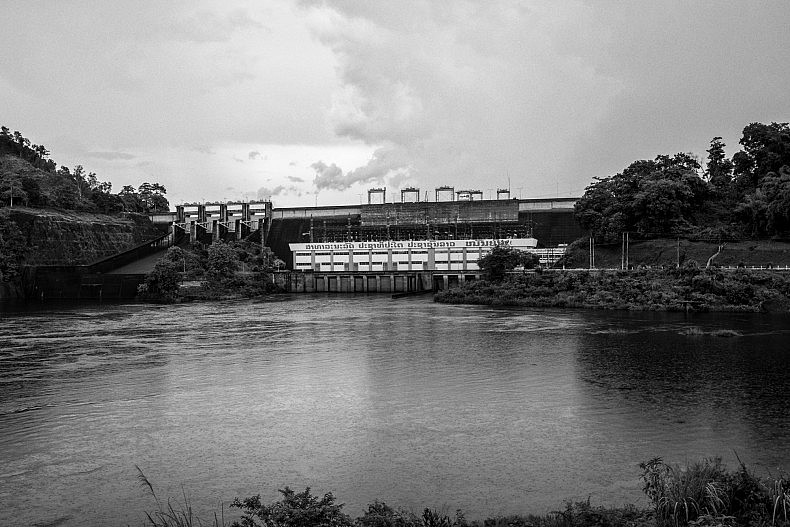
The Nam Ngum dam was completed in 1984. Photo by Gareth Bright.
But when we circled behind the dam to first set eyes on the reservoir, we were surprised by just how beautiful it was. It looked more like the Caribbean than an industrial side effect, and its surface was dotted with idyllic looking micro islands, complete with coconut palms and sandy beaches.
The almost artificially blue surface was dotted with party barges that crisscrossed the calm water, dropping vacationers on uninhabited islands to enjoy a swim and a picnic. Even from high in the hills overlooking the reservoir we could hear their sound systems pumping out local rock ballads.
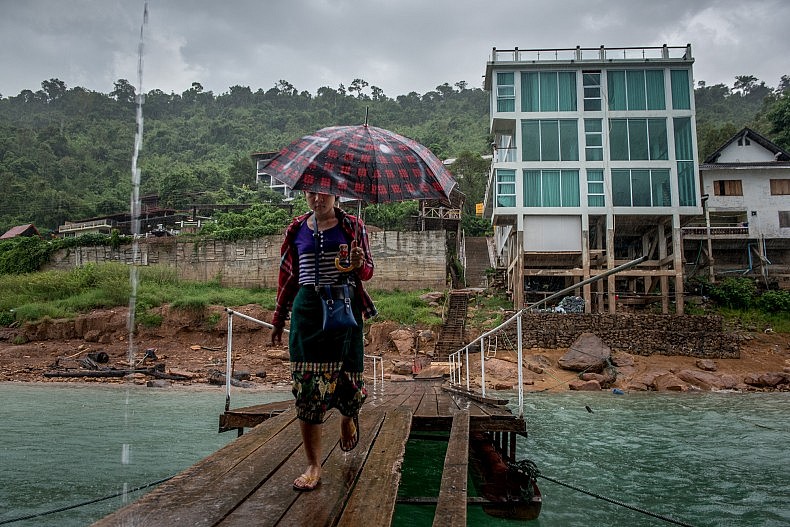
A woman walks towards a floating restaurant on the Nam Ngum dam’s reservoir. Photo by Luc Forsyth.
Expensive SUVs were parked throughout the village of Baan Thaxan, the small community that served as the main jump off point for the wealthy weekenders coming mainly from the capital, Vientiane. Boutique hotels– $100 per night–with blinding white walls and sparkling glass facades jutted out from the mountainsides, no doubt providing lovely sunset views for its guests.
Despite the picture postcard surroundings, however, we knew that there was an underlying conflict of interest. As nice as the hotels must have been for those coming for a weekend of sun and relaxation, they stood in glaring contrast to the rest of Baan Thaxan which was made up mostly of tin-roofed shacks and wooden fishing boats. Whenever development of that nature took place, we knew, someone was usually on the wrong end of progress.
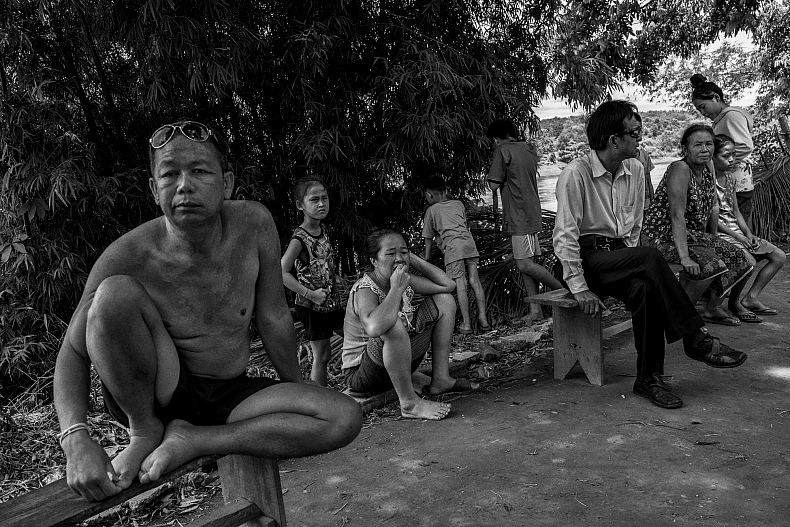
People in the village of Baan Thaxan. Photo by Gareth Bright.
When the Water Rose
“My village used to be surrounded by rice fields,” 50-year-old Mai Boun Ya Vong told us, “but it was turned into an island by the dam.” We met Vong in the village of Baan Thaxan as he was unloading his day’s catch of fish and he took a short break from his work to talk with us. He didn’t seem angry or resentful, rather he spoke like someone explaining unchangeable universal truths.
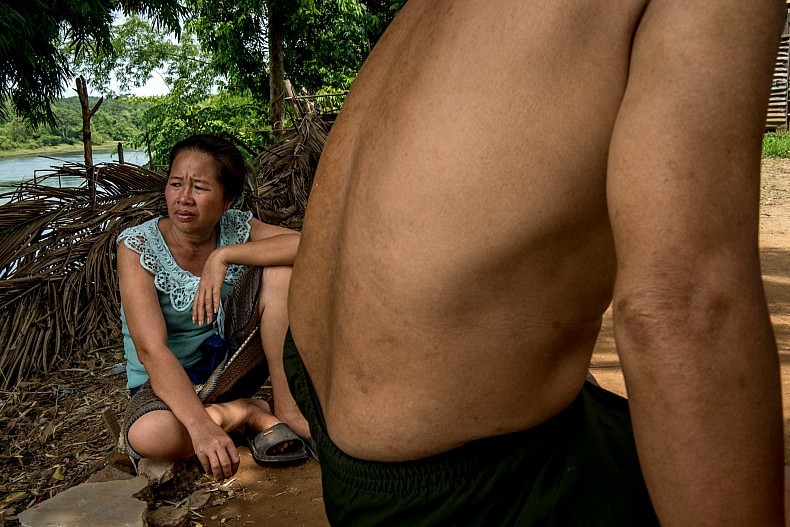
A woman who was forcibly relocated from her home to make way for the reservoir of the Nam Ngum dam. Photo by Luc Forsyth.
Despite the fact that his family had found itself unexpectedly living on an island, for a time they prospered. Many of the fish that had lived in the Nam Ngum river also flourished in the reservoir and their community was well placed to catch them. In fact the population expanded as more and more people moved to the island, which had become one of the most productive fisheries in the area – though at the expense of the river itself, which had been badly damaged ecologically. While some people still fished in the river, Vong told us, most shifted their activities to the reservoir.
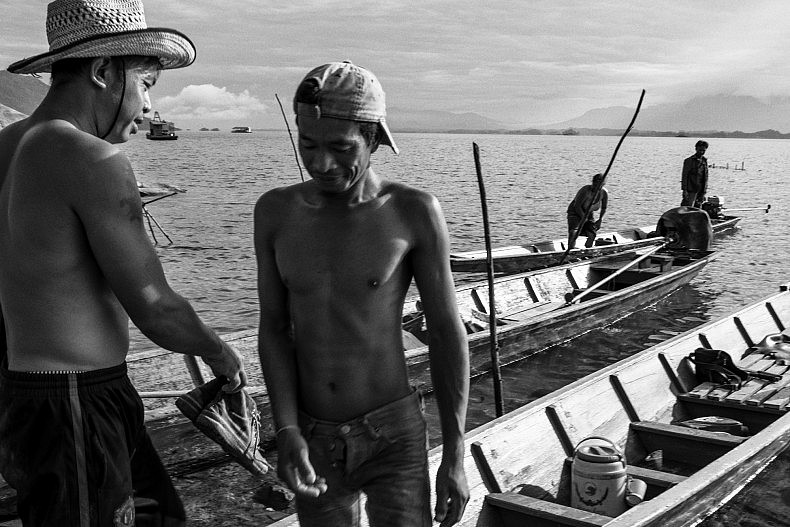
Fishermen on the Nam Ngum dam’s reservoir. Photo by Gareth Bright.
This rapid growth turned out to be the village’s demise, as the government did not like the idea of a large population in a remote and relatively inaccessible area that they could not effectively monitor or control. Eventually officials visited to say they it was unsafe for people to live without electricity – somewhat ironically as the nation’s largest electricity generator was being built less than a kilometer away – and told them they must prepare to relocate.
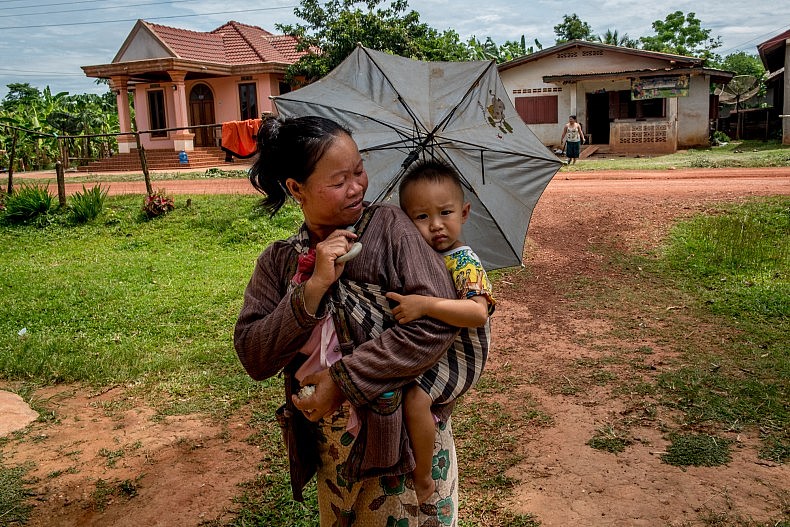
A mother protects her yougn son from the afternoon sun in the village of Baan Thaxan. Photo by Luc Forsyth.
The government resettlement area, however, was away from the water and so therefore badly placed for the needs of a fishing family, and Vong’s father rejected the deal. They had to abandon their home and buy a new plot of land in Baan Thaxan, which was far more developed in terms of infrastructure, but also made for more difficult fishing.
“Life here is different,” Vong told us. “There we had lots of fish and life was easy, but there was no electricity or roads. Now we have power and roads, but it’s much harder to make money [from fishing].”
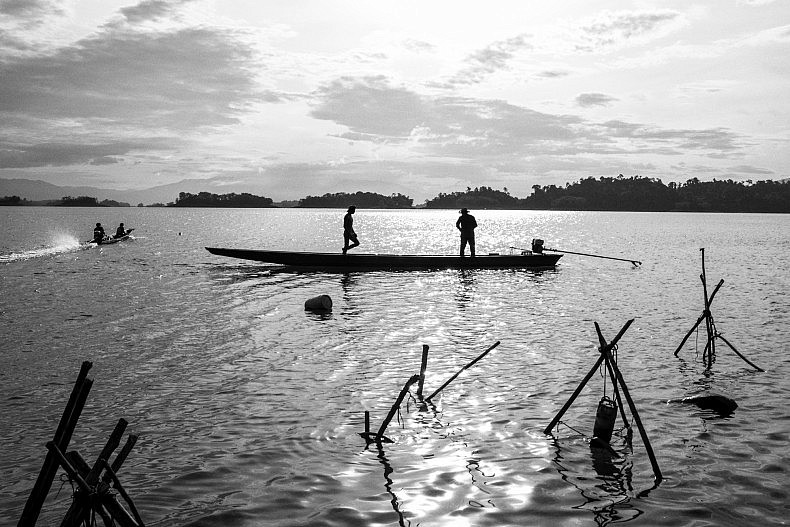
Fishermen on the Nam Ngum dam’s reservoir. Photo by Gareth Bright.
When we asked Vong which he preferred, he had no decisive answer. “I don’t know which is better. They’re just different.” His wife, however, had no such indecision. For her, an island life of abundant fish was the better choice and she said she would immediately return if given the choice.
Despite the government’s policy about living on the islands of the reservoir, Vong told us that a few people still had homes on some of them. Wanting to see for ourselves, we chartered a boat and headed out on the sea. After an hour of motoring we spotted a cluster of small wooden huts on one of the sea’s central islands, tucked into a small inlet hidden from view of the shore.
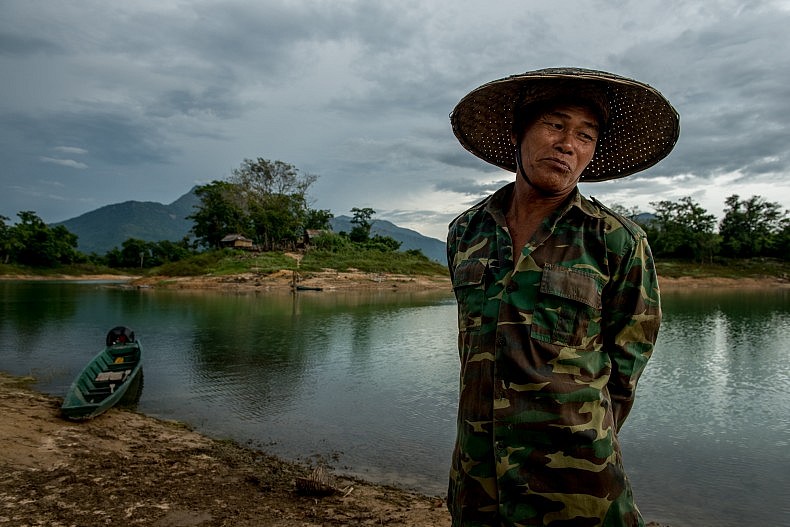
Si Phan, 62, is a fisherman who lives part time on an island in the middle of the Nam Ngum dam’s reservoir. Photo by Luc Forsyth.
Si Phan, a 62-year-old fisherman who split his time between the island and a small house in Thalat, was the only person on the beach when we jumped off the boat. When we asked him the same question as we’d posed to Vong, he answered quickly: “If I had to choose between only living here or my house in Thalat, I would live here. There are no loud parties and I can fish easily. If you live in the city you always have to go markets and restaurants to get what you need, but here I have everything, like fish and vegetables. I even have enough power from solar panels to watch TV at night.”
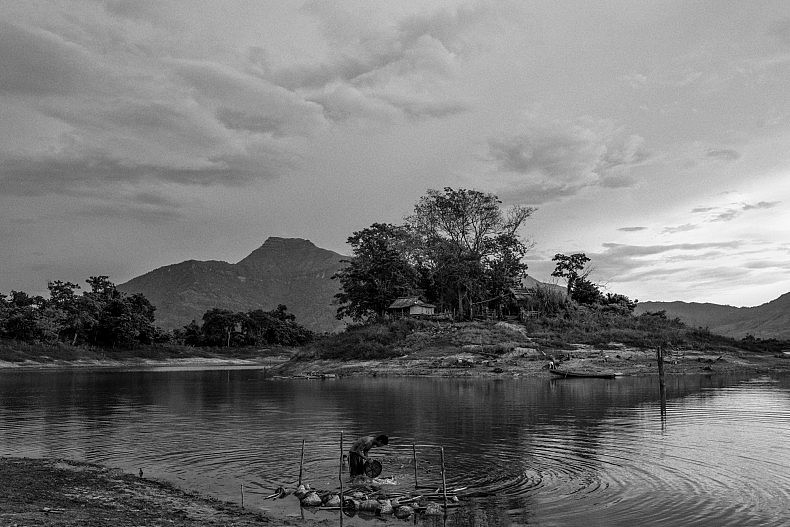
An island in the reservoir. Photo by Gareth Bright.
For locals it seemed as though the Nam Ngum dam was neither entirely good or completely bad. Many of them had lost their homes, but in exchange they had gotten access to modern infrastructure. On one hand the Nam Ngum river had been badly affected and was no longer the productive fishery it once was, but on the other they had gained a sea.
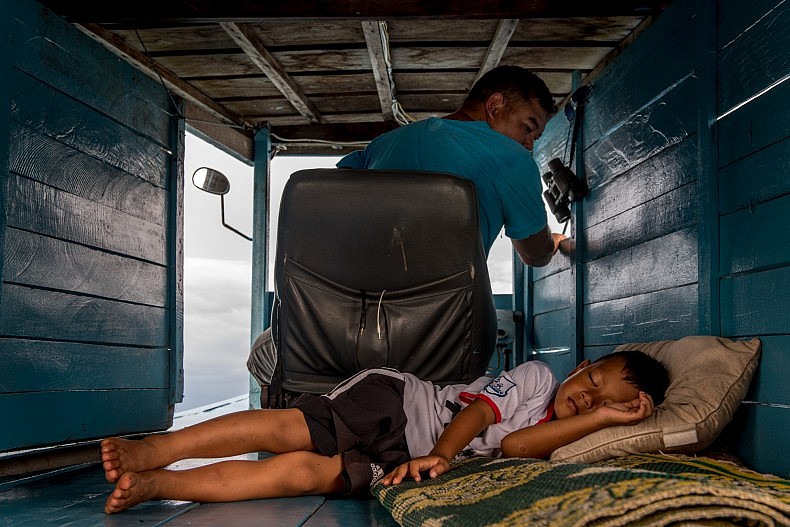
A boat captain checks on his sleeping son as he drives across the reservoir formed by the Nam Ngum dam. Photo by Luc Forsyth.
As the sun began to set the driver of our boat urged us to head back to shore, and so we said farewell to Si Phan. As we left we asked why he had to buy his own solar panels when there was such an abundance of power nearby. “The government says the islands are too difficult to get the lines to,” he responded. To us this seemed odd as Nam Ngum’s electricity was sent hundreds of kilometers away to power the nation’s cities and we figured that “difficult” was a substitute word for low priority.
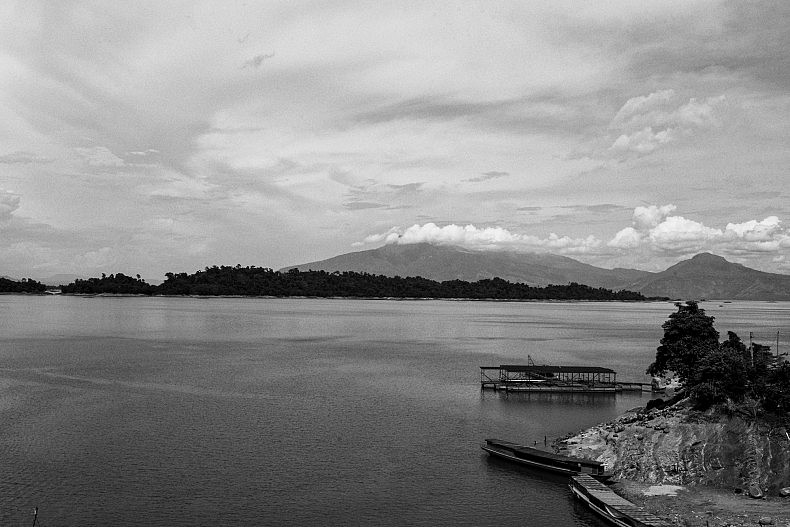
The vast reservoir created by the Nam Ngum dam has been dubbed “The Laos Sea” by many locals. Photo by Gareth Bright.
In parting we asked if he would be able to watch TV that night, and he looked skywards as if trying to remember how much the sun had shone that day.
“Maybe.”
This piece originally appeared at A River’s Tail.













